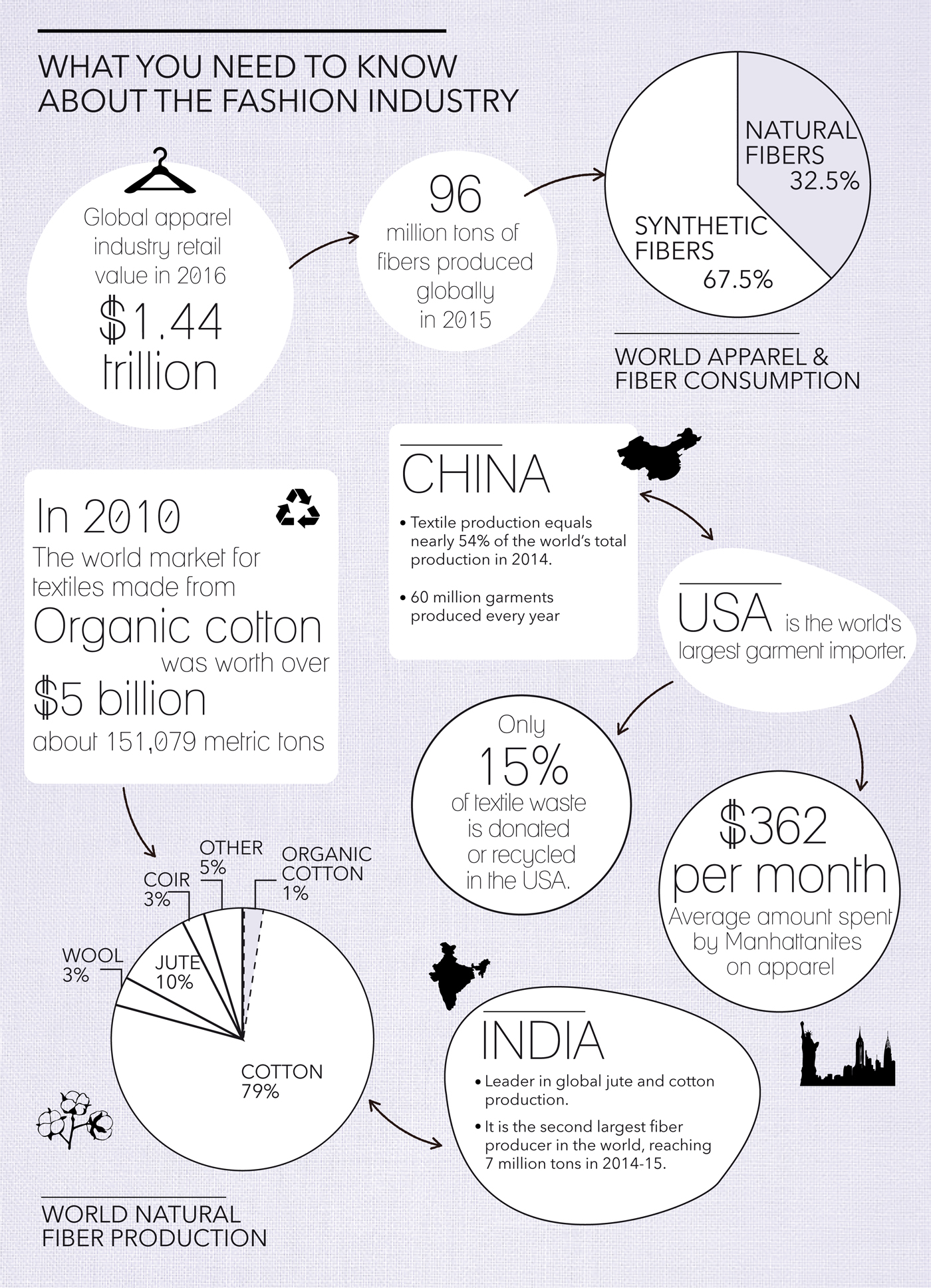
Diagram by Magali An Berthon, © Cooper Hewitt Smithsonian Design, 2016.
In the past forty years, the scale and the geographical distribution of production of the textile, clothing and footwear industries have changed dramatically. The per capita world fiber consumption is in constant growth and has increased evenly in developed and developing countries. It was 6.6 pounds in 1959, and has reached 24 pounds in 2011. In response, giants of the global apparel industry are in the race to meet this demand and to produce more new textile items every year. It is impossible to know the portion of garments that remains unsold or that is sent to landfills. This phenomenon of world fashion overconsumption is well described in Overdressed: The Shockingly High Cost of Cheap Fashion (2012) by journalist Elizabeth Cline. Clothing Poverty: The Hidden World of Fast Fashion and Second-hand Clothes (2015) written by Andrew Brooks, analyzes the functioning of the textile and garment industry and shows its consequences on a global level. Beyond this alarming diagnosis, in Fashion and Sustainability: Design for Change (2012), sustainable fashion researcher Kate Fletcher suggests a series of achievable alternatives to modify our relationship to clothes, implement holistic design processes, and mindfully produce garments in accordance with environment-friendly practices.
Infographic Sources:
Huang, Nick. “Textile and Fashion Industry Facts” in Business Vibes, November 23, 2011. Accessed May 12, 2016. https://www.businessvibes.com/blog/textile-and-fashion-industry-facts
International Cotton Advisory Committee (ICAC) and Food and Agriculture Organization of the United Nations (FAO). World Apparel Fiber Consumption Survey. Washington, DC, July 2013.
Stotz, Lina Stotz, and Gillian Kane. Facts on The Global Garment Industry. Clean Clothes Campaign, 2015. Accessed on February 10, 2016. http://www.cleanclothes.org/resources/publications/factsheets/general-factsheet-garment-industry-february-2015.pdf/view
About the Author
Magali An Berthon is a textile researcher and designer, focusing in particular on world textile crafts and sustainable fashion. After an MFA in textile design in Paris, she studied textile history at the Fashion Institute of Technology NY on a Fulbright fellowship in 2014. Since June 2015, she is a curatorial fellow at the Textile Department at Cooper Hewitt, Smithsonian Design Museum.
Scraps Stories
This post is part of the blog series Scraps Stories dedicated to exploring sustainable textiles and fashion, in relation to the exhibition Scraps: Fashion, Textiles, and Creative Reuse.
4 thoughts on “Infographic: Global Apparel and Textile Insights”
Celia on October 19, 2016 at 8:37 pm
I work for thePhilippine Textile Research Institute and am very keen to establish a culture of mindful consumption and responsible production processes. We have to craft similar undertakings to promote the advocacy and I am thankful to have come across SCRAPS. I will want to do the same thing. thank you and all best.
Celia Elumba
Magali An Berthon on October 20, 2016 at 9:40 am
Dear Celia, we are delighted to know that Scraps and the platform Scraps Series have been an inspiration to you and for your projects at the Philippine Textile Research Institute. Please don’t hesitate to be in touch again, if you wish to have more information. You are also very welcome if you want to share some of your thoughts and projects in the comments section of the upcoming articles. Best wishes,
Sarah Kain on November 28, 2016 at 5:03 pm
Dear Celia, I am fascinated by your Scraps info and blog! Since 1986, I have been designing and selling limited edition clothing made from designer ,left over yards of fabrics , that I purchase from Paron Fabrics in Manhattan. I would love to show you some of my designs.
Truly,
Sarah Kain
(Sarahkaindresses on Facebook) and I would love to work at the museum at Cooper Union!
ConnectedBin on September 29, 2018 at 12:39 pm
Hello,
we, ConnectedBin (www.connectedbin.eu) are a startup that makes IoT smart sensors for used-clothes collection containers.
We help the textile recycling companies optimize the efficiency of their operations, thus helping the overall fiber recovery cycle.
We find it really hard to identify such recyclers outside of Europe, so any help will be greatly appreciated!
Thanks!